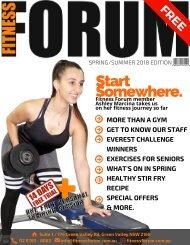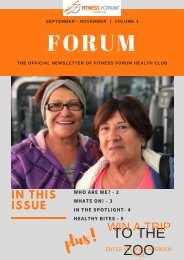You also want an ePaper? Increase the reach of your titles
YUMPU automatically turns print PDFs into web optimized ePapers that Google loves.
EASY EXERCISES FOR<br />
SENIORS<br />
Senior Personal Trainer Daniel Gullo discusses the benefits<br />
of training into your 50's and beyond!<br />
by Daniel Gullo<br />
F F H C<br />
F E A T U R E<br />
Our lovely senior<br />
members: Jenny<br />
Thomson and Maria<br />
Giuliani train almost<br />
every day. They say<br />
the gym is a great<br />
stress reflief and are<br />
inspired by like<br />
minded members &<br />
friendly staff.<br />
"Going to gym makes me feel<br />
uplifted, happy and full of<br />
laughter." - Jenny Thomson<br />
O<br />
nce we get to 50 years and<br />
above, our bodies start to<br />
physically decline. This includes<br />
loss of muscle mass, bone density,<br />
strength, stamina, balance and<br />
mobility. A combination of these<br />
greatly increases the chance of<br />
serious injury.<br />
The lack of balance, mobility and<br />
strength means seniors have a far<br />
greater risk of falls. The decrease<br />
in bone density means that a<br />
simple fall that a younger person<br />
would “shake off”, often leads to<br />
broken bones for an older person.<br />
Whilst there are any things that<br />
decrease as we get older, many<br />
things also increase. The risk of<br />
high blood pressure, coronary<br />
heart disease, cardiovascular and<br />
respiratory problems, stroke and<br />
also depression and anxiety.<br />
All of the above lead to a lack of<br />
independence as we get older,<br />
meaning we rely on our children,<br />
family or carers to perform simple<br />
tasks for us.<br />
This means that older adults<br />
overall quality of life severely<br />
decreases.Thankfully, there is one<br />
thing that can help.<br />
EXERCISE!<br />
Exercise is proven to help slow<br />
down the loss of (and in some<br />
cases even improve!) muscle mass,<br />
bone density, strength, stamina,<br />
balance and mobility whilst also<br />
decreasing risk of the above<br />
mentioned health conditions.<br />
Sit to stand: Stand in front of a<br />
chair or bench, with your feet<br />
shoulder width apart. Keeping<br />
your feet flat on the floor and<br />
putting your weight through your<br />
heels, sit down on the<br />
chair/bench. Once you’ve sat<br />
down, drive through your heels<br />
and stand up straight. Repeat this<br />
8-15 times for 3 sets, depending<br />
on your ability. This will improve<br />
your lower body strength and<br />
endurance.<br />
Single Leg Balance: Stand in front<br />
of a surface you can grab, in case<br />
you lose balance. Stand and<br />
balance on one leg. Aim to hold<br />
for 10-30 seconds on each leg and<br />
complete these 3 times. This will<br />
greatly improve your balance and<br />
help prevent falls.<br />
Step Ups: Use an appropriate<br />
height step, depending on your<br />
current mobility and strength<br />
level. Step up onto the step and<br />
step back down to the floor.<br />
Ensure your knees do not roll in<br />
when you step up. They should<br />
remain in line with your toes. A<br />
normal stair is a good height to<br />
start with. To advance it, use a<br />
higher step, such as a small stool<br />
(about milk crate height). Repeat<br />
this 8-15 times on each leg for 3<br />
sets, depending on your ability.<br />
This will improve your lower body<br />
strength, balance and also<br />
cardiovascular endurance.




